
Navajo National Monument • Shonto, Arizona
Journal Entry
August 15, 2015
From a distance, through a camera lens, Betatakin looks for all the world like a perfect miniature village replete with tiny trees and little replica wooden ladders. Even today, when I show my students some of my telephoto images of the site, I feel compelled to assure them that it’s not a dollhouse or shadowbox. Betatakin is a spectacular, well-preserved, large-scale village dwarfed by the massively high stone alcove in which it was built, an enormously arching natural cave that formed in the sandstone cliff face millions of years before people chose it for their home. Breathtaking seems hardly a strong enough word to describe this amazing place. The Navajo National Monument is administered by the National Park Service but is located on the reservation of the Navajo Tribe. As is the generous policy of the tribe—they view the ruins as sacred—there is no charge for visiting the ancient sites located here.
What You Will See
You begin your odyssey back to the time of Betatakin at the visitor center and museum. From the center, a reasonably easy hike on the paved Sandal Trail along the canyon rim takes you in 0.62 mile to a splendid overlook of Betatakin (I.15). The photographs I’ve included here were all taken from that overlook with an assortment of zoom lens (Figures 66 and 67, the latter taken with a honking huge 600mm lens; you won’t get that image with your cell phone). Once you’re done at the overlook, turn around and hike back to the visitor center. Other trails, including Aspen (0.41 mile each way) and Canyon View (0.32 mile each way), provide other vantages of the canyon.


The more adventurous, and those who aren’t satisfied with the distant view afforded by the Sandal Trail, can register for a guided hike that takes you down into the canyon and right to the ruins. Expect a 3- to 5-hour, 5-mile round-trip with some fairly strenuous walking—700 feet down into the canyon and then, saving the best for last, a 700-foot climb back up at the end of the tour. It’s certainly worth the trip but is not recommended for people with heart, respiratory, hip, or knee problems or other health issues.
Why Is Betatakin Important?
Many of the sites included in this book are picturesque; in fact, a beautiful or awe-inspiring appearance was one of the informal criteria I used in selecting these fifty sites. But Betatakin is remarkable even within those fifty spectacular sites. Even from—maybe especially from—the overlook, the village and its setting are truly breathtaking, a spectacular achievement of architecture as art in the late thirteenth century, when the primary construction took place.
Betatakin is important as an example of how a people carved a life out of what might seem to many of us the harsh surroundings of the canyonlands of the American Southwest. The residents of Betatakin and hundreds of other, generally smaller sites were agricultural, planting corn, beans, and squash in the rich soil that bordered the stream at the base of the canyon. Their potters produced lovely ceramics, painted with a distinctive series of black-and-white geometric designs. The residents of Betatakin worshipped in their kiva, the same kind of structure used by their Hopi descendants to this day for religious ceremonies. They painted their clan symbol on the sheer cliff face about their village. And then, at around AD 1300, the residents of Betatakin left, perhaps as the result of a long-term drought that affected the region at the end of the thirteenth century. The community was occupied only briefly, perhaps no more than fifty years, but during that short period they produced a splendid place that today we can view and marvel at.
Additional Note
While you get spectacular views of the cliff dwelling from the paved canyon rim trail, during summer there are two moderately strenuous guided hikes each day down to the ruins: one at 8:15 a.m. and one at 10 a.m. During winter there’s one hike each day, leaving the visitor center at 10 a.m., when weather and staffing permit. Because the tours are limited and weather can cause their cancellation, always call ahead (928-672-2700) to reserve a spot and confirm the schedule.
Site Type: Cliff Dwelling
Wow Factor: ***** The Betatakin cliff dwelling is mind-blowing. To get a deep appreciation of its beauty from the trail, you’ll need binoculars; to take a great photo, you’ll need a big telephoto lens. Sorry; that camera on your smart-phone just won’t cut it. Or you’ll need to sign up for the hike down into the canyon.
Museum: ****
Ease of Road Access: *****
Ease of Hike: *** The rim trail hike to the overlook where you can get a great view of the cliff dwelling is pretty easy; it’s paved, making it reasonably accessible by wheelchair.
Natural Beauty of Surroundings: **** Gorgeous views from along the rim trail
Kid Friendly: ***
Food: Bring your own.
How to Get There: Betatakin is located in the Navajo National Monument. Take US 160 to AZ 564. Plug this address into your GPS for specific directions: Navajo National Monument, Shonto, Arizona.
Hours of Operation: Open daily 8 a.m. to 6 p.m. late May through mid-September; 9 a.m. to 5 p.m. mid-September through late May
Cost: Free
Best Season to Visit: Summer is hot but dry. The hike along the rim is pretty easy, so heat shouldn’t be a problem if you’re in good health.
Website: www.nps.gov/nava/index.htm
Designation: National Monument